Continuing education and clinical training within healthcare is a modern necessity. Exponential increases in new medical devices and treatments make caregiving a continually evolving field that requires nurses, physicians, technicians, and medical assistants to engage in training in classroom settings, e-learning, and blended learning throughout their careers. Similarly, as EMRs near full implementation across the US healthcare system, the administrative side of healthcare will necessitate healthcare workers to learn and adapt to new processes and technologies. Training needs are compounded as workers often must maintain deep subject matter expertise as well as keep abreast of new tools and technologies, which are advancing at a very rapid pace.
To close these gaps in competency and skill, health systems have turned to learning management systems to handle the vast amounts of continual training needed in the modern healthcare industry. And as a company that’s been pioneering talent management and learning management tools for more than twenty years, Technomedia has developed a new Learning and Development solution that allows health system administrators to design and deliver complete learning courses for a variety of development activities to support self-paced and live training in virtual and classroom settings or through virtual coaching, simulations, and distance learning.
Technomedia’s customers can choose from a wide library of content—including more than a thousand healthcare-specific training courses—from OpenSesame or any other content provider, and the LMS plus included content is implemented as an integrated solution. Additionally, it also allows health systems to create and upload their own content without having to rely on Technomedia, making it simple for organizations to apply blended strategies that incorporate formal and informal learning.
“Hospitals and clinics with such solutions have lower training costs because they don’t need as many physical training facilities within the building, and of course patients receive better care because the staff is receiving better training.”
“The solution can be completely managed by a nontechnical individual. You don’t need an internal IT person to upload new content or add users,” says Olivier Servelle, a subject matter expert at Technomedia.
The Learning and Development tool operates on a software-as-a-subscription-service model, which means it does not require health systems to purchase any hardware.
“For the customer, it means fast deployment,” says William Neale, Technomedia’s director of marketing. “As it’s a preconfigured solution and content is already there, administrators can purchase and deploy the solution within a short period of time.”
When administrators log in, they see a dashboard view that allows them to assign and track learning activities, ensuring employees complete certain learnings. At the same time, the tools allow administrators to streamline operational activities, to facilitate enrollment and asset scheduling, and to capture learner feedback to evaluate and improve instructor and curriculum quality.
“There are also many organizational benefits that relate to the implementation of a modern SaaS-based training solution,” Neale says. “Hospitals and clinics with such solutions have lower training costs because they don’t need as many physical training facilities within the building, and of course patients receive better care because the staff is receiving better training.”
The Learning and Development tool also integrates with Technomedia’s PeopleVision data visualization and dashboarding software, which allows administrators to measure key performance indicators across the entire organization and track the success of their learning programs.
“We designed the solution interface specifically for mobile devices and to be really intuitive for people,” says Olivier Servelle. “Employees today want to be able to pick up their cellphone or iPad, access their learning activities, and search for content just like they would at home on YouTube.”
The mobile-friendly, device-agnostic nature of the solution also makes it available for users on a 24/7 basis. Additionally, the solution has gamification and social aspects, so healthcare workers can earn badges and trophies for completing certain trainings and then share their achievements with their colleagues.
“Users are able to access a community where they can communicate and share content,” Servelle says. “The solution can then recommend pertinent learning activities within these online communities.”
The social and gamification aspects are designed to ensure better employee engagement, which is essential to organizational commitment and better training outcomes, according to a study by Human Resource Development Quarterly. And in healthcare, better training outcomes are critical to success.
“At the end of day, what’s most important is for technical staff, nurses, and other healthcare workers to receive the best training possible,” Neale says.” Ultimately, that means better overall care and more lives saved.”


